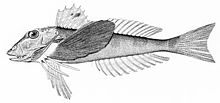- Prionotus carolinus
-
Prionotus carolinus, commonly known as the Northern or Common Sea Robin or gurnard, is a species of sea robin found on the east coast of the United States.
Prionotus carolinus 
Prionotus carolinus Scientific classification Kingdom: Animalia Phylum: Chordata Class: Actinopterygii Order: Scorpaeniformes Family: Triglidae Genus: Prionotus Species: P. carolinus Contents
Description
The northern sea robin can be identified by its spiny head, tapering body, blue eyes[1], and large, fanlike pectoral fins. Three lower rays of the northern sea robin's pectoral fins are feelers used to "walk" along the bottom, so as to stir up bottom sediments to find food. Northern searobins grow to an average of 17 inches (43 cm) long.[2]
Habitat and range
Northern Sea Robins are found in the waters from Southern New England and New York to Cape Hatteras, North Carolina, where they are found in estuaries to the edge of the continental shelf. They prefer the sandy bottoms of the waterbed, where they feed by kicking up sediment to find food, using their "legs".
Diet
The northern sea robin feeds on a wide variety of invertebrates, including shrimp, crabs, amphipods, squid, bivalve mollusks, and segmented worms. It has also been known to bite readily on any bait, suggesting a fairly nonselective feeding habit.[3]
Fishing
Northern sea robin are primarily fished for sport, but are edible. The spines make it difficult to clean, and so are usually considered a nuisance, and thrown back.[4]
References
- ^ http://www.edc.uri.edu/restoration/html/gallery/fish/robin.htm
- ^ Willauer, P. 2002. "Prionotus carolinus" (On-line), Animal Diversity Web. Accessed October 27, 2009 at http://animaldiversity.ummz.umich.edu/site/accounts/information/Prionotus_carolinus.html.
- ^ http://www.edc.uri.edu/restoration/html/gallery/fish/robin.htm
- ^ Willauer, P. 2002. "Prionotus carolinus" (On-line), Animal Diversity Web. Accessed October 27, 2009 at http://animaldiversity.ummz.umich.edu/site/accounts/information/Prionotus_carolinus.html.

This Scorpaeniformes article is a stub. You can help Wikipedia by expanding it.
